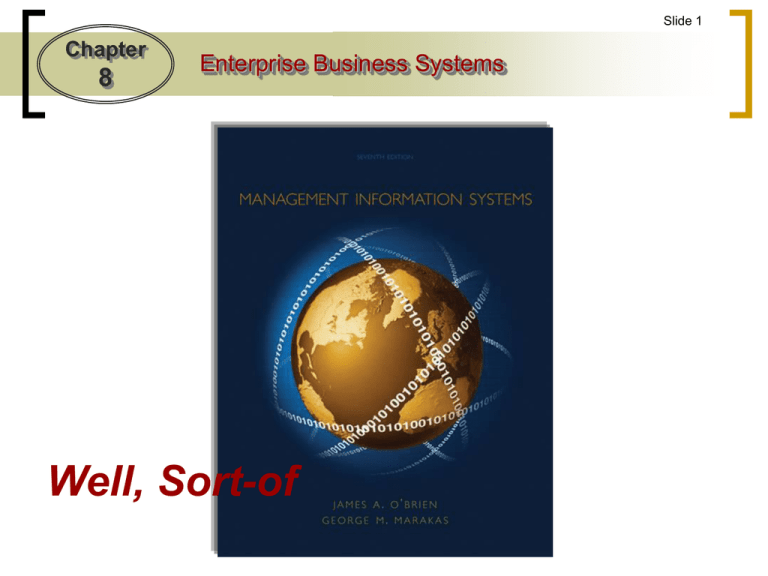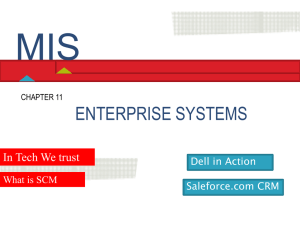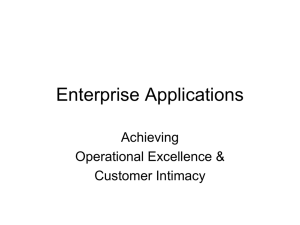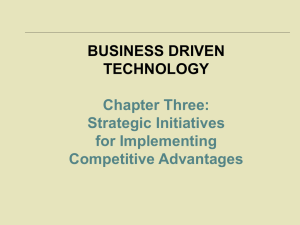Enterprise Business Systems
advertisement

Slide 1 Chapter 8 Enterprise Business Systems Well, Sort-of Slide 2 Chapter 8 Enterprise Business Systems What are enterprise business systems? Good Question!! The term Enterprise Content Management (ECM) refers to the technologies used to capture, manage, store, preserve, and deliver content and documents related to organizational processes. ECM tools & strategies allow the management of an organization's unstructured information, wherever that information exists. So is that what we will be studying? Not really. We will look at: Customer Relationship Management (CRM) Enterprise Resource Planning (ERP) Supply Chain Management (SCM) Slide 3 Chapter 8 Enterprise Business Systems What is Customer Relationship Management (CRM)? The use of information technology to create a cross-functional enterprise system that integrates and automates many of the customer-serving processes in sales, marketing, and customer services that interact with a company’s customers Slide 4 Chapter 8 Enterprise Business Systems What is Customer Relationship Management (CRM)? • Contact and Account Management: helps sales, marketing, and service professionals capture and track relevant data about every past and planned contact with prospects and customers, as well as other business and life cycle events of customers • Sales: provides sales reps with tools and company data sources needed to support and manage sales activities, and optimize crossselling and up-selling Slide 5 Chapter 8 Enterprise Business Systems What is Customer Relationship Management (CRM)? • Marketing Fulfillment: help marketing professionals accomplish direct marketing campaigns by automating such tasks as qualifying leads for targeted marketing, and scheduling and tracking direct marketing mailings • Customer Service and Support: provides service reps with software tools and real-time access to the common customer database shared by sales and marketing professionals Slide 6 Chapter 8 Enterprise Business Systems What is Customer Relationship Management (CRM)? • Retention and Loyalty Programs: help a company identify, reward, and market to their most loyal and profitable customers Slide 7 Chapter 8 Enterprise Business Systems What is Customer Relationship Management (CRM)? • Retention and Loyalty Programs: Consider the following: It costs six times more to sell to a new customer than to sell to an existing customer A dissatisfied customer will tell 8 – 10 people about their unpleasant experience A company can boost profits 85% by increasing annual customer retention by 5% The odds of selling a product to a new customer are 15%; the odds of selling a product to an existing customer are 50% 70% of complaining customers will do business with the company again if it quickly takes care of a service problem Slide 8 Chapter 8 Enterprise Business Systems What are the phases of CRM? Slide 9 Chapter 8 Enterprise Business Systems What are the phases of CRM? • Acquire new customers by doing a superior job of contact management, sales prospecting, selling, direct marketing, and fulfillment Direct Marketing Interactive Marketing Targeted Marketing Promotions • Enhance relationship with customer by supporting superior service from a responsive networked team of sales and service specialists and business partners Cross/Up-Sell Improved customer support • Retain and expand business with customers by proactively identifying and rewarding the most loyal and profitable customers Proactive Services Slide 10 Chapter 8 Enterprise Business Systems What are the benefits of CRM? CRM allows a business to identify and target their best customers so they can be retained as lifelong customers for greater and more profitable services. CRM makes possible real-time customization and personalization of products and services based on customer wants, needs, buying habits, and life cycles. CRM can keep track of when a customer contacts the company, regardless of the contact point. CRM systems can enable a company to provide a consistent customer experience and superior service and support across all the contact points a customer chooses Slide 11 Chapter 8 Enterprise Business Systems Why do CRMs Fail? Lack of understanding and preparation. Rely on CRM to solve business problem without first developing the business process changes and change management programs that are required. CRM projects implemented without the participation of the business stakeholders involved. Slide 12 Chapter 8 Enterprise Business Systems What are the trends in CRM? Operational CRM: Support convenient customer interaction through a variety of media, including phone, fax, e-mail, chat, cell phone Synchronize customer interactions across all media Make your company easier to do business with Analytical CRM: Extract in-depth customer history, preferences and profitability information from various databases Encourage analysis, prediction and definition of customer values, behaviors and demands Approach customers with relevant information and offer products and services tailored to their needs Slide 13 Chapter 8 Enterprise Business Systems What are the trends in CRM? Collaborative CRM: Enable easy collaboration with customers, suppliers and partners Improve efficiency and integration through the supply chain Improve responsiveness to customer needs through sourcing of products and services outside your enterprise Portal-based CRM: Provide users with tools and information that fit their individual roles and preferences Empower employees to respond to customer demands ,ore quickly and become customer-focused Provide instant access and linkage and use all internal and external customer information Slide 14 Chapter 8 Enterprise Business Systems What is Partner Relationship Management (PRM)? Applications that apply many of the same tools used in CRM systems to enhance collaboration between a company and its business partners, such as distributors and dealers, to better coordinate and optimize sales and service to customers across all marketing channels Slide 15 Chapter 8 Enterprise Business Systems What is Enterprise Resource Planning (ERP)? A cross-functional enterprise system driven by an integrated suite of software modules that supports the basic internal business processes of a company Slide 16 Chapter 8 Enterprise Business Systems What ERP Process & Information Flows are needed? Slide 17 Chapter 8 Enterprise Business Systems What are the benefits of ERP? • Quality and Efficiency: ERP creates a framework for integrating and improving a company’s internal business processes that results in significant improvements in the quality and efficiency of customer service, production, and distribution • Decreased Costs: Significant reductions in transaction processing costs and hardware, software, and IT support staff • Decision Support: Provides vital cross-functional information on business performance quickly to managers to significantly improve their ability to make better decisions in a timely manner • Enterprise Agility: ERP breaks down many former departmental and functional walls of business processes, information systems, and information resources Slide 18 Chapter 8 Enterprise Business Systems What are the costs of ERP? Slide 19 Chapter 8 Enterprise Business Systems What are the trends in ERP? Slide 20 Chapter 8 Enterprise Business Systems Why do ERPs fail? Business mangers and IT professionals underestimate the complexity of the planning, development, and training needed Failure to involve affected employees in the planning and development phases Trying to do too much too fast in the conversion process Failure to do enough data conversion and testing Slide 21 Chapter 8 Enterprise Business Systems What is Supply Chain Management (SCM)? A cross-functional inter-enterprise system that uses information technology to help support and manage the links between some of a company’s key business processes and those of its suppliers, customers, and business partners Slide 22 Chapter 8 Enterprise Business Systems What are the objectives of SCM? Slide 23 Chapter 8 Enterprise Business Systems What is the role of SCM? Slide 24 Chapter 8 Enterprise Business Systems What does a SCM do? • Materials Management: share accurate inventory and procurement order information, ensure materials required for production are available in the right place at the right time, and reduce raw material spending, procurement costs, safety stocks, and raw material and finished goods inventory • Collaborative Manufacturing: optimize plans and schedules while considering resource, material, and dependency constraints Slide 25 Chapter 8 Enterprise Business Systems What does a SCM do? • Collaborative Fulfillment: commit to delivery dates in real time, fulfill orders from all channels on time with order management, transportation planning, and vehicle scheduling, and support the entire logistics process, including picking, packing, shipping, and delivery in foreign countries • Supply Chain Event Management: monitor every stage of the supply chain process, from price quotation to the moment the customer receives the product, and receive alerts when problems arise Slide 26 Chapter 8 Enterprise Business Systems What does a SCM do? • Supply Chain Performance Management: report key measurements in the supply chain, such as filling rates, order cycle times, and capacity utilization Slide 27 Chapter 8 Enterprise Business Systems What are the trends in SCM? Slide 28 Chapter 8 Enterprise Business Systems What are the benefits of SCM? Faster, more accurate order processing. Reductions in inventory levels. Quicker times to market. Lower transaction and material costs. Strategic relationship with suppliers. Slide 29 Chapter 8 Enterprise Business Systems Why do SCMs fail? Lack of proper demand planning knowledge, tools and guidelines Inaccurate or overoptimistic demand forecasts Inaccurate production, inventory and other business data provided by a company’s other information systems Lack of adequate collaboration among marketing, production, and inventory management departments within a company Immature, incomplete or hard to implement SCM software tools Slide 30 Chapter 8 Enterprise Business Systems What is Electronic Data Interchange (EDI)? The electronic exchange of business transaction documents over the Internet and other networks between supply chain trading partners Slide 31 Chapter 8 Enterprise Business Systems What is it, really??? A set of standards for structuring information to be electronically exchanged between and within businesses, organizations, government entities and other groups The standards describe structures that emulate documents, for example purchase orders to automate purchasing. The term EDI is also used to refer to the implementation and operation of systems and processes for creating, transmitting, and receiving EDI documents. Slide 32 Chapter 8 Enterprise Business Systems What activities are involved? Slide 33 Chapter 8 Enterprise Business Systems Are there any Questions???









